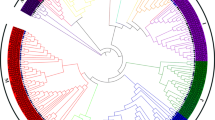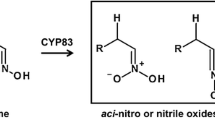Abstract
Betula platyphylla Sukaczev tetraploids have significantly larger leaf, fruit and stoma (gigantic phenotype) than diploids of the same species; however, the mechanism underlying this difference remains unclear. Tetraploid B. platyphylla transcriptome data have indicated that the expression of genes related to indole-3-acetic acid (IAA) biosynthesis and signal transduction was altered after genome duplication. IAA exerts pleiotropic effects on growth and development by inducing the expression of Aux/IAA. We identified 20 Aux/IAA genes (BpIAA1–BpIAA20) in B. platyphylla distributed across 10 chromosomes. Multiple alignment and motif analyses revealed that nine BpIAA proteins shared all four conserved domains. Phylogenetic analysis indicated that Aux/IAA families were divided into four subfamilies and that there were two pairs of BpIAA sister genes. The BpIAAs were differentially expressed in diploids and tetraploids. Moreover, the expression levels of the nine BpIAA genes were specifically up-regulated in tetraploids from June to September compared with May (except August 5th) in tetraploids, while they were down-regulated in diploids. IAA levels were more than twofold higher in tetraploids than diploids during the vegetative season. These results indicate that genome duplication of B. platyphylla caused the up-regulated of genes involved in IAA synthesis, and the increased concentration of IAA may induce the constitutive expression of 20 BpIAA genes. Therefore, the significant changes in the expression patterns of the BpIAAs contributed to the gigantic phenotype of tetraploids to some extent. Our research sheds light on the phenotypic variations observed in B. platyphylla tetraploids.








Similar content being viewed by others
Abbreviations
- Aux/IAA:
-
Auxin/indole-3-acetic acid protein
- ARF:
-
Auxin response factor
- IAA:
-
Indole-3-acetic acid
- KEGG:
-
Kyoto Encyclopedia of Genes and Genomes
- AUX1 :
-
Auxin influx transporter 1
- GH3 :
-
Gretchen hagen 3
- SRUR :
-
Small auxin-up RNA
- DEUs:
-
Differentially expressed unigenes
- NCBI:
-
National Center for Biotechnology Information
- pI:
-
Isoelectric point
- MEGA6:
-
Molecular Evolutionary Genetics Analysis
- MEME:
-
Multiple Expectation Maximization for Motif Elicitation
- CTAB:
-
Hexadecyltrimethylammonium bromide
- qRT PCR:
-
Quantitative real-time reversed transcription PCR
- NR:
-
Non-redundant
- NLS:
-
Nuclear localization sequence
- kDa:
-
The unit of protein molecular mass
References
Bassa C, Mila I, Bouzayen M, Audran-Delalande C (2012) Phenotypes associated with down-regulation of Sl-IAA27 support functional diversity among Aux/IAA family members in tomato. Plant Cell Physiol 53:1583–1595
Buggs RJ, Doust AN, Tate JA, Koh J, Soltis K, Feltus FA, Paterson AH, Soltis PS, Soltis DE (2009) Gene loss and silencing in Tragopogon miscellus (Asteraceae): comparison of natural and synthetic allotetraploids. Heredity 103:73–81
Chang SPJ, Cairney J (1993) A simple and efficient method for isolating RNA from pine trees. Plant Mol Biol Rep 11:113–116
Cui L, Wall PK, Leebens-Mack JH, Lindsay BG, Soltis DE, Doyle JJ, Soltis PS, Carlson JE, Arumuganathan K, Barakat A, Albert VA, Ma H, dePamphilis CW (2006) Widespread genome duplications throughout the history of flowering plants. Genome Res 16:738–749
Devoghalaere et al (2012) A genomics approach to understanding the role of auxin in apple (Malus x domestica) fruit size control. BMC Plant Biol 12:7
Friml J (2003) Auxin transport—shaping the plant. Curr Opin Plant Biol 6:7–12
Fukaki H, Tameda S, Masuda H, Tasaka M (2002) Lateral root formation is blocked by a gain-of-function mutation in the SOLITARY-ROOT/IAA14 gene of Arabidopsis. Plant J 29:153–168
Gao J, Cao X, Shi S, Ma Y, Wang K, Liu S, Chen D, Chen Q, Ma H (2016) Genome-wide survey of Aux/IAA gene family members in potato (Solanum tuberosum): identification, expression analysis, and evaluation of their roles in tuber development. Biochem Biophys Res Commun 471:320–327
Guilfoyle TJ (2015) The PB1 domain in auxin response factor and Aux/IAA proteins: a versatile protein interaction module in the auxin response. Plant Cell 27:33–43
Guilfoyle TJ, Hagen G, Ulmasov T, Murfett J (1998) How does auxin turn on genes? Plant Physiol 118:341–347
Hagen G, Guilfoyle TJ (2002) Auxin-responsive gene expression: genes, promoters and regulatory factors. Plant Mol Biol 49:373–385
Kalluri UC, Difazio SP, Brunner AM, Tuskan GA (2007) Genome-wide analysis of Aux/IAA and ARF gene families in Populus trichocarpa. BMC Plant Biol 7:59
Kim BC, Soh MC, Kang BJ, Furuya M, Nam HG (1996) Two dominant photomorphogenic mutations of Arabidopsis thaliana identified as suppressor mutations of hy2. Plant J 9:441–456
Korasick DA, Westfall CS, Lee SG, Nanao MH, Dumas R, Hagen G, Guilfoyle TJ, Jez JM, Strader LC (2014) Molecular basis for AUXIN RESPONSE FACTOR protein interaction and the control of auxin response repression. Proc Natl Acad Sci USA 111:5427–5432
Ku S-J, Park JY, Ha S-B, Kim J (2009) Overexpression of IAA1 with domain II mutation impairs cell elongation and cell division in inflorescences and leaves of Arabidopsis. J Plant Physiol 166:548–553
Lavy M, Prigge MJ, Tao S, Shain S, Kuo A, Kirchsteiger K, Estelle M (2016) Constitutive auxin response in Physcomitrella reveals complex interactions between Aux/IAA and ARF proteins. eLife. https://doi.org/10.7554/eLife.13325
Leitch AR, Leitch IJ (2008) Genomic plasticity and the diversity of polyploid plants. Science 320:481–483
Li H, Tiwari SB, Hagen G, Guilfoyle TJ (2011) Identical amino acid substitutions in the repression domain of auxin/indole-3-acetic acid proteins have contrasting effects on auxin signaling. Plant Physiol 155:1252–1263
Löve Á (1944) A new triploid Betula verrucosa. Svensk Bot Tidskr 38:381–393
Mu H, Liu Z, Lin L, Li H, Jiang J, Liu G (2012) Transcriptomic analysis of phenotypic changes in birch (Betula platyphylla) autotetraploids. Int J Mol Sci 13:13012–13029
Nagpal P, Walker LM, Young JC, Sonawala A, Timpte C, Estelle M, Reed JW (2000) AXR2 encodes a member of the Aux/IAA protein family. Plant Physiol 123:563–574
Osborn TC, Pires JC, Birchler JA, Auger DL et al (2003) Understanding mechanisms of novel gene expression in polyploids. Trends Genet 19(3):141–147
Parisod C, Holderegger R, Brochmann C (2010) Evolutionary consequences of autopolyploidy. New Phytol 186:5–17
Paul P, Dhandapani V, Rameneni JJ, Li X, Sivanandhan G, Choi SR, Pang W, Im S, Lim YP (2016) Genome-wide analysis and characterization of Aux/IAA family genes in Brassica rapa. PLoS ONE 11:e0151522
Petit M, Guidat C, Daniel J et al (2010) Mobilization of retrotransposons in synthetic allotetraploid tobacco. New Phytol 186:135–147
Pieninkeroinen K, Valanne T (1989) Old colchicine-induced polyploid materials of Betula pendula Roth and Betula pubescens Ehrh. Ann Sci For 46:264s–266s
Qiao LY, Zhang XJ, Han X, Zhang L, Li X et al (2015) A genome-wide analysis of the auxin/indole-3-acetic acid gene family in hexaploid bread wheat (Triticum aestivum L.). Frontiers. Plant Sci 6:770
Reed JW (2001) Roles and activities of Aux/IAA proteins in Arabidopsis. Trends Plant Sci 6:420–425
Rogg LE, Lasswell J, Bartel B (2001) A gain-of-function mutation in IAA28 suppresses lateral root development. Plant Cell 13:465–480
Schmittgen TD, Livak KJ (2008) Analyzing real-time PCR data by the comparative CT method. Nat Protoc 3:1101–1108
Schranz ME, Osborn TC (2004) De novo variation in life-history traits and responses to growth conditions of resynthesized polyploid Brassica napus (Brassicaceae). Am J Bot 91:174–183
Shen C, Yue R, Yang Y, Zhang L, Sun T, Xu L, Tie S, Wang H (2014) Genome-wide identification and expression profiling analysis of the Aux/IAA gene family in Medicago truncatula during the early phase of Sinorhizobium meliloti infection. PLoS ONE 9:e107495
Singh VK, Jain M (2015) Genome-wide survey and comprehensive expression profiling of Aux/IAA gene family in chickpea and soybean. Front Plant Sci. 6:918
Soltis PS (2005) Ancient and recent polyploidy in angiosperms. New Phytol 166:5–8
Song Y, Wang L, Xiong L (2009) Comprehensive expression profiling analysis of OsIAA gene family in developmental processes and in response to phytohormone and stress treatments. Planta 229:577–591
Su L, Bassa C, Audran C, Mila I, Cheniclet C, Chevalier C, Bouzayen M, Roustan JP, Chervin C (2014) The auxin SlIAA17 transcriptional repressor controls fruit size via the regulation of endoreduplication-related cell expansion. Plant Cell Physiol 55:1969–1976
Su LY, Audran C, Bouzayen M, Roustan JP, Chervin C (2015) The Aux/IAA, Sl-IAA17 regulates quality parameters over tomato fruit development. Plant Signal Behav 10:e1071001
Sumimoto H, Kamakura S, Ito T (2007) Structure and function of the PB1 domain, a protein interaction module conserved in animals, fungi, amoebas, and plants. Sci Signal. https://doi.org/10.1126/stke.4012007re6
Tian Q, Reed JW (1999) Control of auxin-regulated root development by the Arabidopsis thaliana SHY2/IAA3 gene. Development 126:711–721
Tiwari SB, Wang XJ, Hagen G, Guilfoyle TJ (2001) AUX/IAA proteins are active repressors, and their stability and activity are modulated by auxin. Plant Cell 13:2809–2822
Tiwari SB, Hagen G, Guilfoyle TJ (2004) Aux/IAA proteins contain a potent transcriptional repression domain. Plant Cell 16:533–543
Walker JC, Key JL (1982) Isolation of cloned cDNAs to auxin-responsive poly (A) RNAs of elongating soybean hypocotyl. Proc Natl Acad Sci USA 79:7185–7189
Wang J, Tian L, Madlung A, Lee HS, Chen M, Lee JJ, Watson B, Kagochi T, Comai L, Chen ZJ (2004) Stochastic and epigenetic changes of gene expression in Arabidopsis polyploids. Genetics 167:1961–1973
Wang S, Zhao H, Jiang J, Liu G, Yang C (2015) Analysis of three types of triterpenoids in tetraploid white birches (Betula platyphylla Suk.) and selection of plus trees. J For Res 26:623–633
Wolfe KH (2001) Yesterday’s polyploids and the mystery of diploidization. Nat Rev Genet 2:333–341
Wu J, Peng Z, Liu S, He Y, Cheng L, Kong F, Wang J, Lu G (2012) Genome-wide analysis of Aux/IAA gene family in Solanaceae species using tomato as a model. Mol Genet Genomics 287:295–311
Wu W, Liu Y, Wang Y, Li H, Liu J, Tan J, He J, Bai J, Ma H (2017) Evolution analysis of the Aux/IAA gene family in plants shows dual origins and variable nuclear localization signals. Int J Mol Sci. https://doi.org/10.3390/ijms18102107
Xie R, Pang S, Ma Y, Deng L, He S, Yi S, Lv Q, Zheng Y (2015) The ARF, AUX/IAA and GH3 gene families in citrus: genome-wide identification and expression analysis during fruitlet drop from abscission zone A. Mol Genet Genomics 290:2089–2105
Yang et al (2004) The IAA1 protein is encoded by AXR5 and is a substrate of SCFTIR1. Plant J 40:772–782
Yang G, Chen S, Wang S, Liu G, Li H, Huang H, Jiang J (2015) BpGH3.5, an early auxin-response gene, regulates root elongation in Betula platyphylla × Betula pendula. Plant Cell, Tissue Organ Cult 120:239–250
Yuan H, Zhao K, Lei H, Shen X, Liu Y, Liao X, Li T (2013) Genome-wide analysis of the GH3 family in apple (Malus × domestica). BMC Genomics 14:297
Author information
Authors and Affiliations
Corresponding author
Additional information
Project funding: This work was supported by the National Natural Science Foundation of China (Grant Nos. 31370660 and 31670673), and the 111 Project (B16010).
The online version is available at http://www.springerlink.com
Corresponding editor: Yu Lei.
Rights and permissions
About this article
Cite this article
Xu, W., Chen, S., Jiang, J. et al. Expression profiling of the BpIAA gene family and the determination of IAA levels in Betula platyphylla tetraploids. J. For. Res. 30, 855–867 (2019). https://doi.org/10.1007/s11676-018-0670-1
Received:
Accepted:
Published:
Issue Date:
DOI: https://doi.org/10.1007/s11676-018-0670-1




